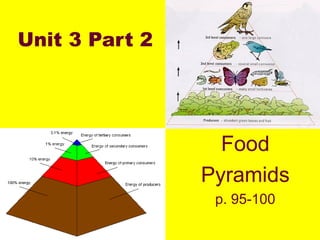
Unit 3 lesson 2 food pyramids
- 1. Unit 3 Part 2 Food Pyramids p. 95-100
- 2. Define Food Pyramid • Diagram showing each trophic level as a horizontal LESS bar. • Producers are located on bottom • Higher consumers are placed on top of each other. MORE • Each bar is drawn in proportion to the mass of organisms • More mass at the lower levels, less at the top… hence the triangular shape!
- 3. Why are there fewer organisms at each trophic level? P. 97 If humans became primary consumers only, then more of the human population could be supported. • As you go up the food chain, less energy is available at each higher level. • (1/10th of lower level). Remember 90% is used up! • Organisms higher up have to eat MORE food from lower levels to survive. • Therefore, fewer organisms can obtain energy to live = fewer organisms are at each higher level.
- 4. Higher means Less! The higher up you go, there is less: a. Mass of organisms – food pyramid b. Number of organisms – pyramid of numbers c. Amount of energy – energy pyramid
- 5. Why is this pyramid upside down? Biological Amplification
- 6. Why is this pyramid upside down? Biological Amplification • Biological Amplification is the tendency of pollutants/toxins to become more concentrated in higher trophic levels. • Often, this is to the detriment of the higher order organisms in which these materials concentrate, since the pollutants are often toxic. • Also referred to as Biological magnification
- 7. Biological Amplification – simplified! • FACT! - Some toxins (DDT & mercury) are stored in fat and are NOT water soluble or excreted. • Plants/organisms at lower levels take in toxins. • Animals higher up eat MANY of these lower organisms to obtain enough energy. • Taking in MORE toxins as well = build up of toxins is much higher in these higher up consumers.
- 8. Consumer- eats 3 fox Coyote = 300 units of toxins built up Consumer- eats 5 Fox = 100 units of toxins rabbits built up Consumer- eats 20 Rabbit = 20 units of toxins shrubs built up Producer Shrub = 1 unit of toxin
- 9. How do food pyramids help explain DDT amplification? P. 97 (Handout!!) • DDT was a particularly dangerous toxin because it is fat soluble and stays in an animal's fat. (Some poisons are water soluble and can be excreted from the system.) • Lower order organisms ingest some poison which is store in their fat. • Higher order organisms eat large numbers of lower order organisms. (Ex. A small amount in a frog becomes large in a hawk that eats 100 frogs.
- 10. Introduction of new species? • What could be the probable impact that: • the recent arrival of coyotes on the island of Newfoundland may have on the local ecosystem? • the introduction of snowshoe hare or even the moose to the island of Newfoundland? • the introduction of chinch bugs when it arrived through sods imported from mainland Canada?
- 11. Possible Effects ??? • Elimination/disruption of their food sources/species. • Competition for food sources may cause decline or endanger other native species that eat same food source. • Diseases or DANGER may be introduced causing decline or disruption. • May cause interruption or decline in economic activity related to lost/declining species. (ex. Moose & Caribou) • Financial cost to subsequently control new species. • May cause the CREATION OF NEW BUSINESSES… to control the species, tourism etc.. • The new plant/animal could be a FOOD SOURCE for the local ecosystem.